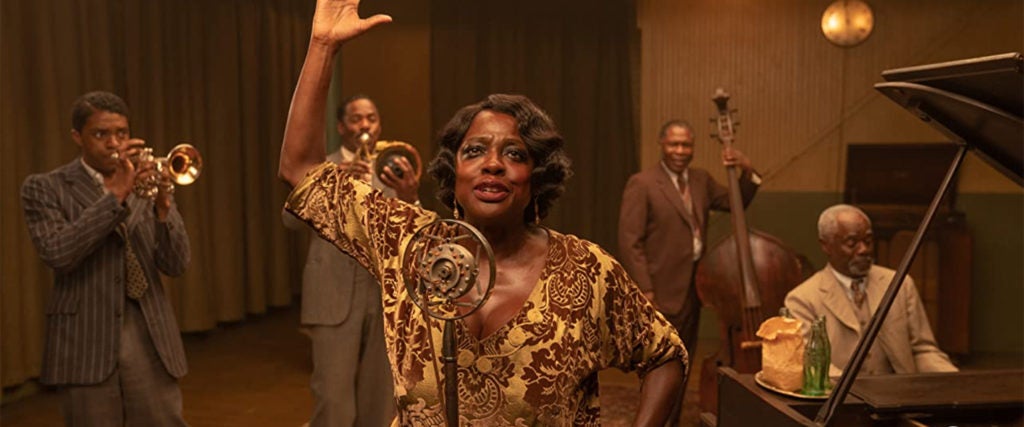Imagine you’re a serious filmmaker, accomplished in the art of the austere. You believe in capturing human behavior with an unblinking eye. You prefer long takes with little to no camera moves. You’re an artist.
Now imagine that when you plop your camera down, the people you’re filming begin performing an entire Broadway play. Are you still an artist? Or are you just a cameraperson?
There’s long been a stigma associated with the “filmed play,” whether it’s a film of an actual live performance, or it’s a movie shot on a set but that holds closely to the original play’s locations and dialogue. This bias has always befuddled me: As someone who loves theater and lives nowhere near New York, I’ve relied for most of my life on movie adaptations and videotapes of stage productions to see some of the greatest plays and musicals of all time. These documents have been essential to my cultural education.
This year, for all its miseries, has been a boon to theater nerds in the boonies, like me. Three major recent Broadway productions have been widely released via subscription streaming services: Hamilton on Disney+, What the Constitution Means to Me on Amazon and David Byrne’s American Utopia on HBO Max (and HBO). A week or so ago, Netflix debuted a movie adaptation of August Wilson’s classic 1982 play Ma Rainey’s Black Bottom, starring Viola Davis as a feisty 1920s blues belter and Chadwick Boseman (in his final screen performance) as her ambitious trumpet player.
As I’ve been perusing various year-end lists of 2020’s best films, I have seen a few of these films pop up — but just occasionally. Ma Rainey has drawn good buzz, and is bound to be a major player in awards season, especially in the acting categories. Spike Lee directed American Utopia, and David Byrne is partly responsible for what’s widely considered the greatest concert film of all time, Stop Making Sense… so that movie does have some critical cachet.
But those two examples are also representative of the hesitancy some critics feel toward hailing a film that’s essentially a straightforward approximation of a stage work. Lee has made several of these kinds of movies throughout his career, including one I personally consider among his Top Five best: Passing Strange, a document of Stew and Heidi Rodewald’s tuneful musical about a Black bohemian’s coming of age. I saw Passing Strange for the first time at the 2009 Sundance Film Festival, and I walked out of the theater feeling moved and energized. But when I talked about the experience later with colleagues who love both Lee and Stew, many of them shrugged, saying the movie was pretty good but that it was ultimately — you guessed it — just a “filmed play.”
I take issue with that dismissal. Although Lee and his crew recorded actual live performances of Passing Strange, they did make creative choices throughout, about where to place their cameras and which angles to include in the final cut. They didn’t just bolt a camera to the balcony and shoot the show straight-on. But even if they had? There’s still value in having a record of that show, with its stirring score and its electric supporting performance by Colman Domingo.
Domingo is also excellent in Ma Rainey’s Black Bottom, a film likely to get more benefit of the doubt from critics because it is a film, shot on sets in Pittsburgh over the course of a month in the summer of 2019. This is the second of producer Denzel Washington’s series of movies based on Wilson’s 10-play, decades-spanning “Century Cycle.” (The first was Washington’s own superb 2016 adaptation of Fences.) These plays are essential pieces of American art, capturing multiple aspects of the Black experience via slice-of-life stories filled with memorable characters and poetic monologues. Few dispute that the play Ma Rainey’s Black Bottom — about the simmering frustrations of an R&B group boiling over during one long, hot recording session — is timelessly brilliant.
Yet the early reactions I’ve seen to the movie version seem hesitant to make the same claims. Critics are quick to praise the cast, and to lament the loss of such a phenomenal talent as Boseman. Fewer (so far at least) have been buzzing about the work done by director George C. Wolfe and cinematographer Tobias A. Schliessler to frame the way these characters circle and poke at each other, on a day so steamy that everyone in the building seems to exude a golden glow.
Let me be clear: I understand that cinema and theater are two vastly different media, even if the people making them are using the same script. Acting in front of a camera requires less projection than acting in front of an audience, which means that films of live performances might feel a little “off” in comparison to films shot as a more traditional movie production. Heidi Schreck’s performance in her play What the Constitution Means to Me, for example, is very big, because she’s trying to connect to the crowd sitting right in front of her.
I also certainly don’t mean to imply that camera angles and moves — the kinds of cinematic expression somewhat limited when filming a live show — aren’t crucial elements to a movie’s overall quality. Editing, too. Sometimes the rhythm of a story or even just a scene plays differently on the stage than it does on the screen, making it necessary to trim some dialogue or to add some locations to “open up” a play.
But I do think it’s possible to let the perfect be the enemy of the good when it comes to judging these films. The way a movie looks absolutely matters. But so does the acting, the writing, the music… all the pieces of a Broadway hit that often don’t need much tweaking, in other words.
Consider the work of arguably Broadway’s greatest composer, Stephen Sondheim. There have only been a few full movie adaptations of his classic shows, and each suffers greatly from attempts to make a stage-bound production feel more like cinema. Nearly all of the adaptations cut too much of the music, either in alarming quantities (as in A Funny Thing Happened on the Way to the Forum and A Little Night Music) or just enough to affect the overall meaning and flow (as in Sweeney Todd: The Demon Barber of Fleet Street and Into the Woods). In the case of Tim Burton’s Sweeney Todd, while the film looks amazing, the choice to cast the non-singers Johnny Depp and Helena Bonham Carter in the leads rendered a robust score fairly bloodless.
That said, if you want to see Sweeney Todd done right — or Into the Woods for that matter, or Sunday in the Park with George, or Company — there have been very good video productions made of all those shows, sometimes from different eras. You can easily find the 2006 Company, with Raúl Esparza as Bobby, or the 2011 one, starring Neil Patrick Harris. Or you could watch the 1970 film Original Cast Album: Company, shot by the documentarian D.A. Pennebaker during the recording session for what would become a beloved LP among Broadway geeks.
Original Cast Album: Company has some cred among cinephiles. (It’s canonical enough to have been parodied by the anthology comedy series Documentary Now! as Original Cast Album: Co-Op.) But few of those movie buffs speak as reverently about the recordings of the 2006 or 2011 shows, even though both offer much more complete versions of Company. Why couldn’t those be considered “documentaries” too, of a kind? Or if that’s too much of a stretch, maybe they could be thought of as concert films, weighed against the likes of Stop Making Sense, The Last Waltz or Amazing Grace — all films that have been hailed as much for their performances and atmosphere as for how they were shot.
Because sure, Schreck’s broadly expressive acting in What the Constitution Means to Me probably wouldn’t fly in a movie-movie. But in the film of her show, director Marielle Heller captures the connection Schreck makes with her audience, as well as how she gradually uses that rapport to shock and provoke. In the film version of Hamilton, director Thomas Kail documents the excitement in the Richard Rodgers Theatre toward the end of the original cast’s run, and gets across how that show comes to life via hundreds of small interactions between the performers as they sing — something that’s not always easy to register while sitting in the audience.
Hamilton has won nearly every award imaginable, and the movie was well-reviewed when it debuted on Disney+. But it now feels like it’s been set aside by critics into its own special category: not a film, not TV, not theater. It’s not making many Top 10 lists. (In the interest of full disclosure, I should say that it landed at No. 16 on mine.)
I understand why that is, and I don’t blame people for thinking there’s something lacking in a filmed play. But I do think they’re thinking too narrowly. So much of live performance is ephemeral. To freeze it, just for a moment? That’s magic.

